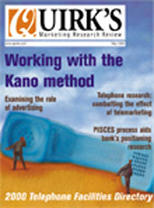'This is not a sales call'
Editor’s note: Jason Stolp is project associate at Q & A Research, Inc., Novato, Calif.
When designing a questionnaire, too often the introduction is merely an afterthought. As market researchers, we are naturally more interested in the meat of the matter, the actual questions that will directly address the study’s objective. However, regardless of how insightful and well-designed the body of the questionnaire is, an ill-conceived introduction may mean that high refusal rates will cause dialing costs to skyrocket, making the research unviable.
Meanwhile, the market research community is growing acutely aware of faltering cooperation rates and blames the telemarketing industry for using deceptive tactics that unfairly bias the public against legitimate opinion research.
In an effort to combat this trend, The Council for Marketing and Opinion Research (CMOR) undertook a study to evaluate, among other things, the effect of common questionnaire introduction components on cooperation rates. (Source: Opinion: The Newsletter Magazine of CMOR, V1, No.1, Winter 1998)
For the most part, any seasoned researcher could have anticipated the results. Disclosing the interview length up front - “This will only take five minutes” - served to increase cooperation, as did identifying the client and the subject matter.
The surprise came when refusal rates of interviews in which the introduction verbiage contained phrases like “This is not a sales call” were compared to questionnaires where no mention of sales was made at all. Far from increasing cooperation rates, these assurances actually increased the number of refusals (51 percent not a sales call; 43 percent “no sales” mention).
Does this unexpected finding undermine the industry’s complaint that telemarketers are to blame for the public’s lack of participation in opinion research?
Hardly. This finding is strong evidence that the practice of “sugging,” or telemarketing under the guise of market research, has become so pervasive that no matter how candid legitimate researchers are about the purpose of their calls, the public hears these assurances like those of the used-car salesman who insists “I’m not here to sell you a car.”
In her article “Helping New Interviewers Avoid Refusals,” Nina Liou of the University of North Carolina at Chapel Hill suggests that the better approach is to equip interviewers with a stock response so they are prepared to address these concerns if and when they come up. “Providing scripted answers to common questions,” Liou writes, “bolsters interviewers’ confidence in their ability to convince respondents to participate and it also makes the interviewer appear more knowledgeable, thereby reducing the likelihood of a refusal.” (For the full article visit www.irss.unc.edu/nnsp/newsletters/nnsp27.pdf)
Instead of putting a “This is not a sales call” phrase in the introduction, develop a phrase that the interviewer can turn to in the event the respondent says, “OK, so what are you selling?” Perhaps something along the lines of “The opinions of consumers like you provide invaluable feedback to Company X in their efforts to continually better the products and services they provide. Do you have a few minutes to help us with your thoughts?” Without resorting to the dubious phrase “This is not a sales call,” the interviewer has effectively defused the situation while at the same time appealing to the average person’s desire to have their opinions count.
Writing introductions that utilize these elements and taking the time to train interviewers with these strategies will make your research a more rewarding experience for respondent and client alike.
